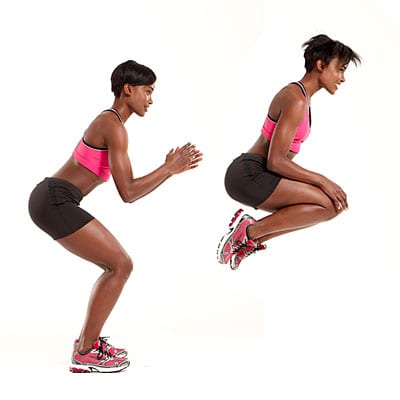Tuck jumps
Tuck jumps, also known as “knee tuck jumps” or “knee to chest jumps” are an exercise for mid-high level athletes, which is categorized among plyometric exercises aimed at developing speed and explosive strength.
Benefits
The purpose of tuck jumps or knee to chest jumps is not only to improve the performance of competitive athletes in the field: anyone who has tried to include them in their workouts will have realized the important energy expenditure, in addition to the considerable cardio component.
In fact, this exercise, despite being part of the bodyweight exercises, lends itself very well as a calorie-killer for all those workouts aimed at weight loss, as long as those who perform them still have good coordination and control of their body.
Remaining instead in terms of performance, tuck jumps see a lot of space wherever you need to improve your anaerobic endurance, as if performed with HIIT intervals they offer a very intense effort that cannot be maintained for very long (compatibly with the correct technique) : sports such as football, basketball, tennis, athletics, combat sports are all examples of possible applications for this purpose.
As for its power in increasing explosiveness, they can be part of a contrasting routine, or seen as separate exercises (see the application proposal at the end of the article).

How are they performed?
Although it is an exercise without loads, the tuck jumps is a very dynamic exercise that requires coordination and an excellent state of health: for this reason I consider it an exercise for medium-high level athletes.
- Starting position in an upright position with feet shoulder-width apart and hands at the sides, abdomen contracted, shoulder blades adducted and spine well extended.
- Keeping the physiological curves and the gaze in front of you, descend into a quarter of a squat bringing your hands behind your hips.
- Push with all your strength towards the ground (as if you wanted to plunge your feet into the ground) by jumping upwards.
- In the flight phase, bring your knees to your chest and touch them with your hands.
- Land on the toes cushioning with the lower limbs.
Muscles involved
Observing the dynamics of the exercise, it is clear that most of the work is done by the lower limbs (calves, tibials, quadriceps, hamstrings, buttocks), however, albeit marginally, the core also remains involved in all those propulsion phases before jumping, gathering the knees to the chest and stabilizing after landing.
Common mistakes
Although it is a simple jump, there are some tricks that can help avoid even annoying injuries and it is therefore good to list the main enemies of our tuck jump:
- keeping the abdomen relaxed (especially when landing)
- lose physiological curves in the loading phase
- land by cushioning on the toes and not on the heel
- try to perform the next jump after an unstable landing (risking to make the next landing dangerous)
- perform this exercise without having completed the necessary warm-up phase
How to insert them in the card?
In light of the above, it can be understood that this exercise has multiple applications based also on its role in the context of the workout.
For example, you want to improve the explosiveness of a Thai boxer during the execution of the jump knee: for professionals, a tuck jump can already in itself resemble a lot in terms of mechanics to this Atlantic gesture and could be inserted as a ring conjunction between a non-specific exercise and a specific exercise within a contrasting routine.
The proposed routine can be inserted within the athletic preparation session aimed at explosiveness:
Progression
The tuck jumps can also be seen as a progression of other exercises already known, to make the union of the two exercises even more stimulating.
Some examples that come to mind can be:
- burpees & tuck jump: involves the execution of a canonical burpee where the final jump phase is formed by a tuck jumps
- rock up & tuck jumps: involves the execution of a rock up (possibly with overload) which in the final phase does not end with the relaxation of the hips but with a tuck jump.
Our articles should be used for informational and educational purposes only and are not intended to be taken as medical advice. If you are concerned, consult a health professional before taking dietary supplements or making major changes to your diet.


























